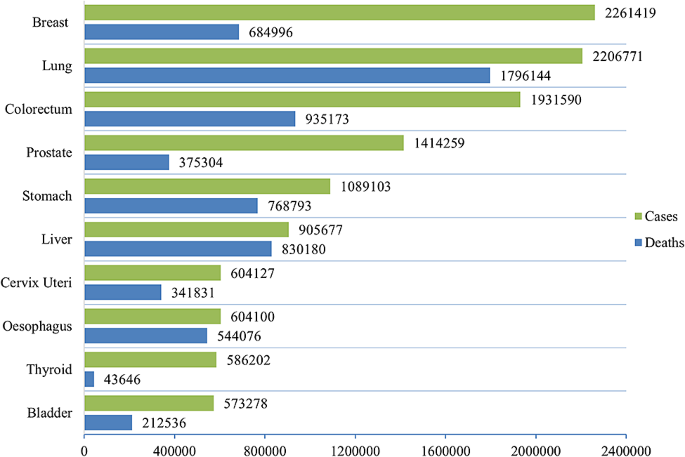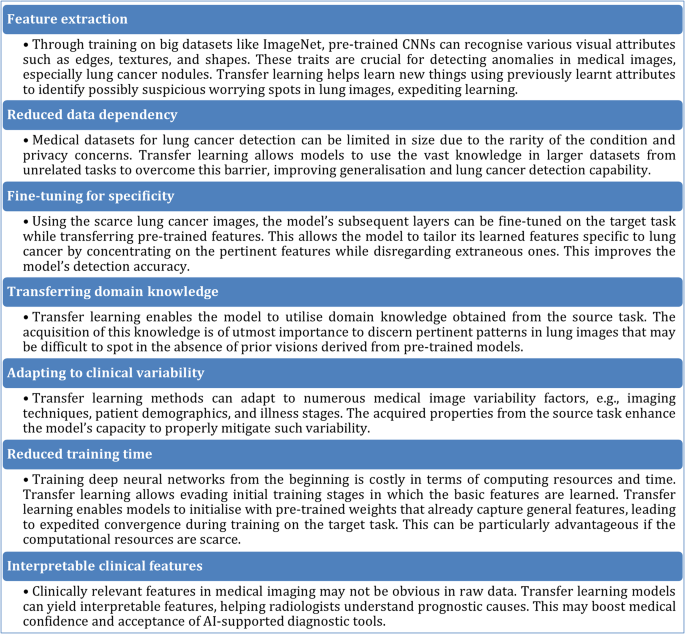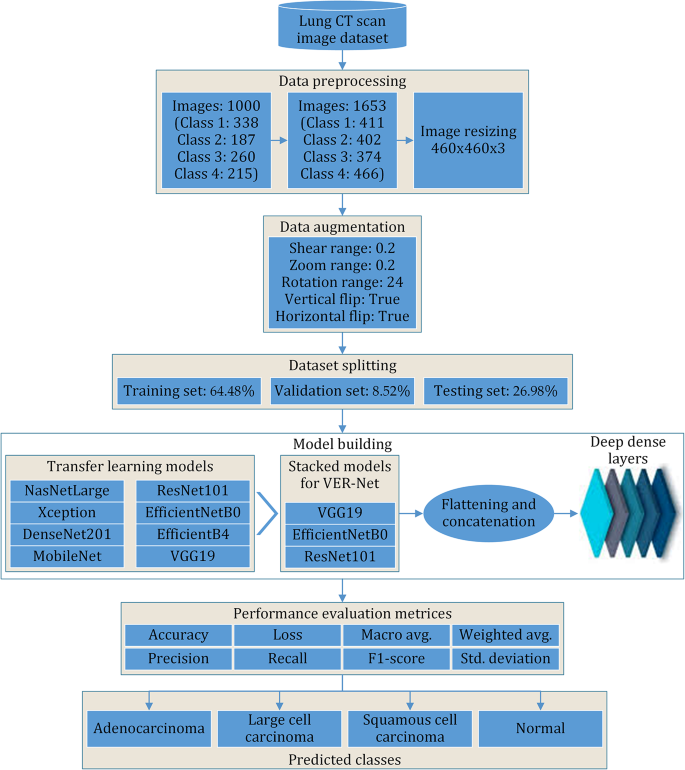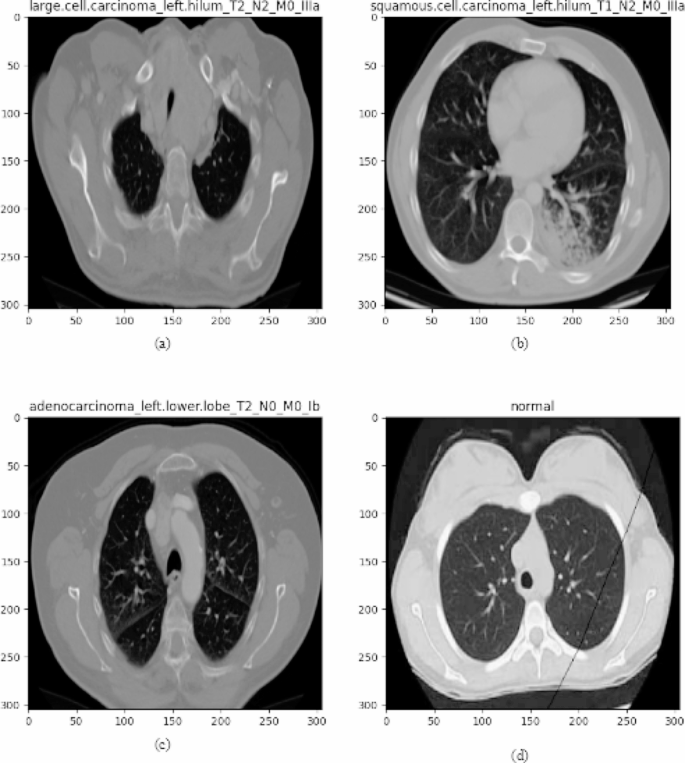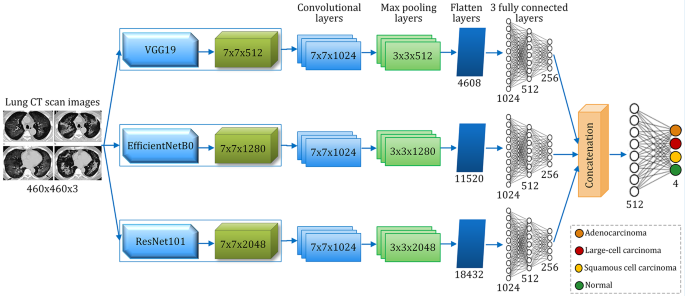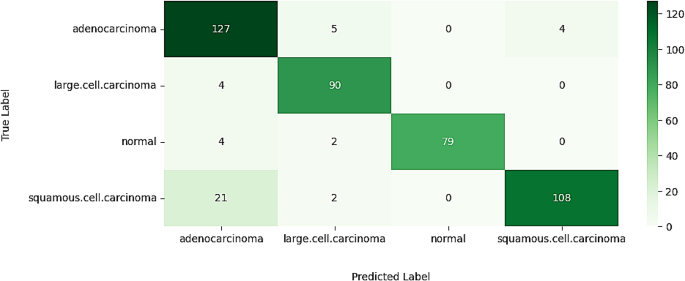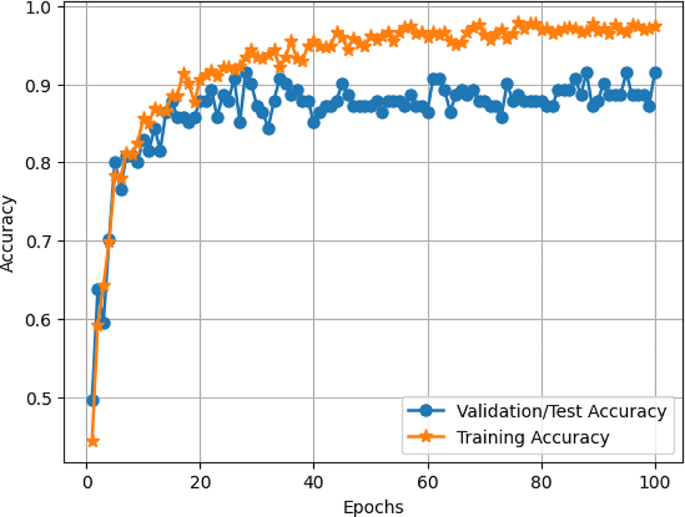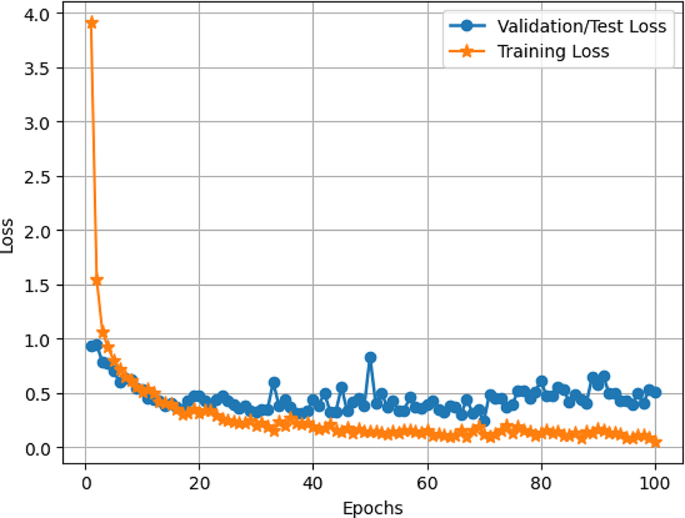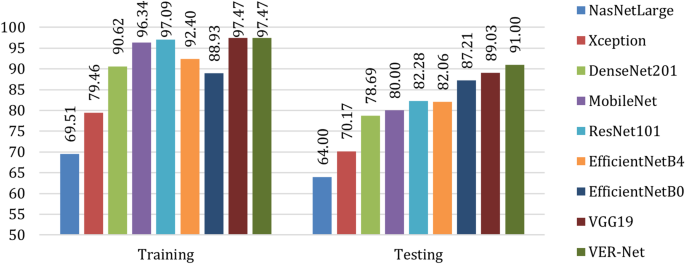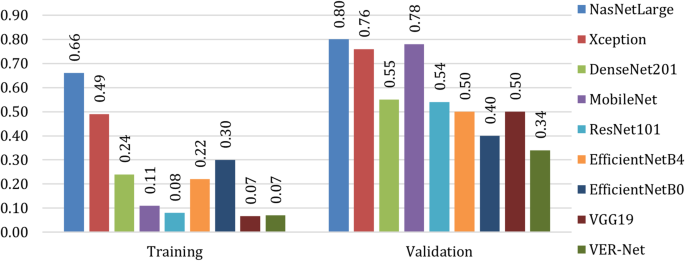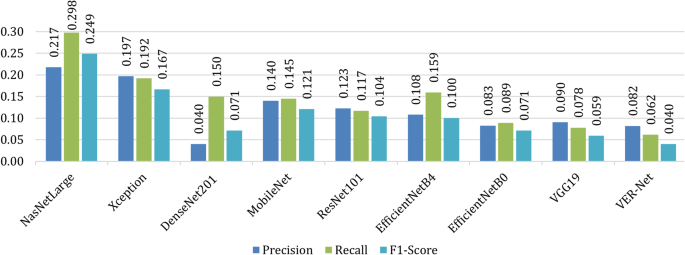- Research
- Open access
- Published:
VER-Net: a hybrid transfer learning model for lung cancer detection using CT scan images
BMC Medical Imaging volume 24, Article number: 120 (2024)
Abstract
Background
Lung cancer is the second most common cancer worldwide, with over two million new cases per year. Early identification would allow healthcare practitioners to handle it more effectively. The advancement of computer-aided detection systems significantly impacted clinical analysis and decision-making on human disease. Towards this, machine learning and deep learning techniques are successfully being applied. Due to several advantages, transfer learning has become popular for disease detection based on image data.
Methods
In this work, we build a novel transfer learning model (VER-Net) by stacking three different transfer learning models to detect lung cancer using lung CT scan images. The model is trained to map the CT scan images with four lung cancer classes. Various measures, such as image preprocessing, data augmentation, and hyperparameter tuning, are taken to improve the efficacy of VER-Net. All the models are trained and evaluated using multiclass classifications chest CT images.
Results
The experimental results confirm that VER-Net outperformed the other eight transfer learning models compared with. VER-Net scored 91%, 92%, 91%, and 91.3% when tested for accuracy, precision, recall, and F1-score, respectively. Compared to the state-of-the-art, VER-Net has better accuracy.
Conclusion
VER-Net is not only effectively used for lung cancer detection but may also be useful for other diseases for which CT scan images are available.
Introduction
Lung cancer is one of the leading causes of cancer-related deaths globally. It is broadly classified as small and non-small-cell lung cancer [1]. Lung cancer is a significant contributor to cancer-related deaths worldwide, with the highest mortality rate among all types of cancer. According to the World Health OrganizationFootnote 1, cancer is a significant contributor to global mortality, resulting in approximately 10 million fatalities in 2020, which accounts for roughly one out of every six deaths. WHO estimated that one in 16 people would be diagnosed with lung cancer worldwide by 2022. Figure 1 represents the incidence cases and deaths of cancers for both sexes and all age groups worldwideFootnote 2. The x-axis represents the number of people, while the y-axis denotes the types of cancers. Amongst all cancers, lung cancer has a significantly higher mortality rate. Additionally, when considering the number of incident cases, lung cancer ranks second among all types of cancer.
Roughly one-third of cancer-related deaths can be attributed to tobacco usage, a high body mass index, alcohol consumption, inadequate consumption of fruits and vegetables, and a lack of physical activity [2]. In addition, international agencies for cancer research have identified several risk factors that contribute to the development of various cancers, including alcohol, dietary exposures, infections, obesity, radiation, and many more that contribute towards cancer diseases. Lung cancer is caused by the abnormal growth of cells that form a tumour and can have serious consequences if left untreated. Early detection and effective treatment can lead to successful cures for many forms of cancer. Also, it is crucial for improving the survival rate and reducing mortality [3].
Lung cancer is a respiratory illness that affects people of all ages. Symptoms of lung cancer include changes in voice, coughing, chest pain, shortness of breath, weight loss, wheezing, and other painful symptoms [4]. Non-small-cell lung cancer has various subtypes, including Adenocarcinoma, squamous cell cancer, and large cell carcinoma, and is frequently observed [5]. However, small-cell lung cancer spreads faster and is often fatal.
Over the decades, clinical pathways and pathological treatments for lung cancer have included chemotherapy, targeted drugs, and immunotherapy [6]. In hospitals, doctors use different imaging techniques; while chest X-rays are the most cost-effective method of diagnosis, they require skilled radiologists to interpret the images accurately, as these can be complex and may overlap with other lung conditions [7]. Various lung diagnosis methods exist in the medical industry that use CT (computed tomography), isotopes, X-rays, MRI (magnetic resonance imaging), etc. [8, 9].
Manual identification of lung cancer can be a time-consuming process subject to interpretation, causing delays in diagnosis and treatment. Additionally, the severity of the disease infection may not be apparent on X-ray images.
As artificial intelligence (AI) has advanced, deep learning has become increasingly popular in analyzing medical images. Deep learning is a technique that can automatically discover high dimensionality, as compared to the more intuitive visual assessment of images that is often performed by skilled clinicians [10,11,12]. Convolutional neural networks (CNNs) are promising for extracting more powerful and deeper features from these images [13]. Significant improvements have been achieved in the potential to identify images and extract features inside images due to the development of CNN [14, 15]. Advanced CNNs have been shown to improve the accuracy of predictions significantly. In recent years, the development of computer-aided detection (CAD) has shown promising results in medical image analysis [16, 17]. Deep learning techniques, particularly transfer learning, have emerged as a powerful technique for leveraging pre-trained models and improving the performance of deep learning models [18].
Transfer learning has gained significant attention and success in various fields of AI, including medical image diagnosis [19], computer vision [20], natural language processing [21], speech recognition [22], and many more. Transfer learning involves using pre-trained neural networks to take the knowledge gained from one task (source task) and apply it to a different but related task (target task) [23]. In transfer learning, a model pre-trained on a large dataset for a specific task can be fine-tuned on similar datasets for different tasks.
Transfer learning has recently shown much promise in making it easier to detect lung cancer from medical imaging data. Integrating transfer learning methodologies into pipelines for lung cancer detection has demonstrated enhanced accuracy and efficiency across multiple research investigations. It offers a practical and effective way to leverage existing knowledge and resources to develop accurate and efficient models for lung cancer detection. It starts with a pre-trained CNN model and fine-tunes its layers on a dataset of lung images. This allows the model to quickly learn to identify relevant features associated with lung cancer without requiring extensive labelled lung cancer images. The advantages of transfer learning for lung cancer detection are listed in Fig. 2.
In this paper, we employed different transfer learning models for lung cancer detection using CT images. We proposed a hybrid model to enhance the prediction capability of the pre-trained models. The key contributions of this paper are:
-
1.
The original image dataset is resized into 460 × 460 × 3.
-
2.
Random oversampling is applied to fuse synthetic images in the minority class.
-
3.
Data augmentation is applied by applying shear_range, zoom_range, rotation_range, horizontal_flip, and vertical_flip.
-
4.
Eight transfer learning models, viz. NASNetLarge, Xception, DenseNet201, MobileNet, ResNet101, EfficientNetB0, EfficientNetB4, and VGG19 are tried with the processed dataset.
-
5.
A novel transfer learning model (VER-Net) is built by stacking VGG19, EfficientNetB0, and ResNet101. The outputs of all three models are individually flattened and concatenated afterwards.
-
6.
Seven deep dense layers are added to optimize the performance of VER-Net.
-
7.
The performance of VER-Net is validated on eight different matrices (accuracy, loss, precision, recall, F1-score, macro average, weighted average, and standard deviation) and compared with the other eight considered models.
-
8.
The accuracy of VER-Net is compared with the state-of-the-art.
The rest of the paper is organized as follows. Similar recent research addressing identifying lung cancer through transfer learning is discussed in Sect. 2. The working principle, details of the dataset preparation, and considered transfer learning models are discussed in Sect. 3. Section 4 presents the details of the proposed stacking model, including architecture and parameters. Section 5 presents the proposed model’s experimental details, results, and performance analysis. Section 6 concludes the paper, mentioning the limitations of this study and future scopes.
Related work
Deep learning techniques provide reliable, consistent, and accurate results. Due to this, they are widely applied across multiple domains to solve real-world problems [24,25,26,27]. Researchers have carried out diverse literature that includes datasets, algorithms, and methodology to facilitate future research in the classification and detection of lung cancer. Some of the prominent attempts to detect lung cancer using transfer learning are discussed in this section.
Wang et al. [28] experimented with a novel residual neural network with a transfer learning technique to identify pathology in lung cancer subtypes from medical images for an accurate and reliable diagnosis. The suggested model was pre-trained on the public medical image dataset luna16 and fine-tuned using their intellectual property lung cancer dataset from Shandong Provincial Hospital. Their approach accurately identifies pathological lung cancer from CT scans at 85.71%. Han et al. [29] developed a framework to assess the potential of PET/CT images in distinguishing between different histologic subtypes of non-small cell lung cancer (NSCLC). They evaluated ten feature selection techniques, ten machine learning models, and the VGG16 deep learning algorithm to construct an optimal classification model. The VGG16 achieved the highest accuracy rate of 84.1% among all the models. Vijayan et al. [30] employed three optimizers with six deep learning models. These models included AlexNet, GoogleNet, ResNet, Inception V3, EfficientNet b0, and SqueezeNet. While evaluating the various models, their effectiveness is measured by comparing their results with a stochastic gradient, momentum, Adam, and RMSProp optimization strategies. According to the findings of their study, GoogleNet using Adam as the optimizer achieves an accuracy of 92.08%. Nóbrega et al. [31] developed the classification model using deep transfer learning based on CT scan lung images. Several feature extraction models, including VGG16, VGG19, MobileNet, Xception, InceptionV3, ResNet50, Inception-ResNet-V2, DenseNet169, DenseNet201, NASNetMobile and NASNetLarge, were utilized to analyze the Lung Image Database Consortium and Image Database Resource Initiative (LIDC/IDRI). Among all the algorithms, the CNN-ResNet50 and SVM-RBF (support vector machine– radial basis function) combination was found to be the most effective deep extractor and classifier for identifying lung nodule malignancy in chest CT images, achieving an accuracy of 88.41% and an AUC of 93.19%. The authors have calculated the other performance evaluation matrices to validate the proposed model. Dadgar & Neshat [32] proposed a novel hybrid convolutional deep transfer learning model to detect three common types of lung cancer - Squamous Cell Carcinoma (SCC), Large Cell Carcinoma (LCC), and Adenocarcinoma. The model included several pre-trained deep learning architectures, such as VGG16, ResNet152V2, MobileNetV3 (small and large), InceptionResNetV2, and EfficientNetV2, which were compared and evaluated in combination with fully connected, dropout, and batch-normalization layers, with adjustments made to the hyper-parameters. After preprocessing 1000 CT scans from a public dataset, the best-performing model was identified as InceptionResNetV2 with transfer learning, achieving an accuracy of 91.1%, precision of 84.9%, AUC of 95.8%, and F1-score of 81.5% in classifying three types of lung cancer from normal samples. Worku et al. [33] proposed a denoising first two-path CNN (DFD-Net) for lung cancer detection. During preprocessing, a residual learning denoising model (DR-Net) is used to remove the noise. Then, a two-path convolutional neural network was used to identify lung cancer, with the denoised image from DR-Net as an input. The combined integration of local and global aspects is the main emphasis of the two pathways. Further, the performance of the model was enhanced, and a method other than the traditional feature concatenation techniques was employed, which directly integrated two sets of features from several CNN layers. Also, the authors overcame image label imbalance difficulties and achieved an accuracy of 87.8% for predicting lung cancer. Sari et al. [34] implemented CAD system using deep learning on CT images to classify lung cancer. They used transfer learning and a modified ResNet50 architecture to classify lung cancer images into four categories. The results obtained from this modified architecture show an accuracy of 93.33%, sensitivity of 92.75%, precision of 93.75%, F1-score of 93.25%, and AUC of 0.559. The study found that the modified ResNet50 outperforms the other two architectures, EfficientNetB1 and AlexNet, in accurately classifying lung cancer images into Adenocarcinoma, large carcinoma, normal, and squamous carcinoma categories.
Overall, these studies show that transfer learning has the potential to improve how well medical imaging data can be used to find lung cancer. Using pre-trained deep neural networks can significantly reduce the need for large datasets and reduce training time, making them more accessible for clinical applications. However, more research is needed to find the best architecture for transfer learning and the best fine-tuning strategy for spotting lung cancer. Further studies can focus on improving the interpretability and generalization of transfer learning models for real-world applications.
Research methodology
The details of the requirements and experimental steps carried out in this paper are discussed in this section.
Framework
The proposed model follows seven phases of structure, as shown in Fig. 3. After acquiring the chest CT scan images, they were preprocessed and augmented to make the experiment suitable. The processed dataset is divided into training, validation, and testing sets. Eight popular transfer learning models were executed based on this data. Among them, the top three were selected and stacked to build a new prediction model. The model was fine-tuned repeatedly to improve the classification accuracy while reducing the required training time. The model was trained and validated to classify three cancer classes and a normal class. Finally, the model was tested.
Dataset description
The chest CT images utilized in this study were obtained from KaggleFootnote 3. The dataset contains CT scan images of three types of lung cancers: Adenocarcinoma, Large cell carcinoma, and Squamous cell carcinoma. During the cancer prediction process, the lung cancer image dataset taken from Kaggle consists of 1653 CT images, of which 1066 images are used for training, 446 images for testing and the remaining 141 for validation purposes to determine the efficiency of the cancer prediction system. Class-wise samples of lung cancer CT images are depicted in Fig. 4. The detailed distribution of the dataset in terms of the total images, number of images in each class, number of classes, and labelling in each category is elucidated in Table 1.
Adenocarcinoma
Lung adenocarcinomaFootnote 4 is the most common form of lung cancer, accounting for 30% of all cases and about 40% of all non-small cell lung cancer occurrences. Adenocarcinomas are found in several common cancers, including breast, prostate and colorectal. Adenocarcinomas of the lung are found in the outer region of the lung in glands that secrete mucus and help us breathe. Symptoms include coughing, hoarseness, weight loss and weakness.
Large cell carcinoma
Large-cell undifferentiated carcinomaFootnote 5 lung cancer grows and spreads quickly and can be found anywhere in the lung. This type of lung cancer usually accounts for 10 to 15% of all cases. Large-cell undifferentiated carcinoma tends to grow and spread quickly.
Squamous cell carcinoma
Squamous cell carcinomaFootnote 6 is found centrally in the lung, where the larger bronchi join the trachea to the lung or in one of the main airway branches. Squamous cell lung cancer is responsible for about 30% of all non-small cell lung cancers and is generally linked to smoking.
The last category is the normal CT scan images.
Data preprocessing
To develop a robust and reliable automated system, data preprocessing plays a crucial role in the model-building process [35,36,37]. Preprocessing is an essential step to eliminate the distortions from the images. In this study, data preprocessing, image resizing, and data augmentation were used for better classification and detection of lung cancer, as discussed in the subsections below.
Image resizing
The loaded images are standardized and normalized using a standard scaler and min-max scaler as the normalization functions. The files are resized from 224 × 224 to 460 × 460 using a resize function. The classes undergo label encoding, i.e., 0 for class Adenocarcinoma, 1 for class Large cell carcinoma, 2 for class Normal and 3 for class Squamous cell carcinoma.
Data augmentation
Random oversampling was applied afterwards to add randomly duplicate examples in the minority class by adding additional images to the classes containing fewer samples in the dataset. Initially, the dataset comprised 1000 images, with each class containing 338, 187, 260 and 215 images. The final dataset after oversampling contains 1653 images, with each class containing 411, 402, 374 and 466 images, as shown in Table 2.
After that, data augmentation was applied by applying shear_range = 0.2, zoom_range = 0.2, rotation_range = 24, horizontal_flip = True, and vertical_flip = True. Finally, the dataset is split into training, testing and validation in 64.48%, 26.98% and 8.52%, respectively. After the preprocessing followed by the Train-test split, the data is fed to models for training.
Transfer learning models
Transfer learning models play a significant role in healthcare for medical image processing [23, 31]. Medical imaging technologies, such as X-rays, CT scans, MRI scans, and histopathology slides, generate vast amounts of visual data that require accurate and efficient analysis. Transfer learning enables the utilization of pre-trained models trained on large datasets from various domains, such as natural images, to tackle medical image processing tasks [28]. The transfer learning models that are considered in this experiment are described in this section.
NasNetLarge
Google created the NasNetLarge [38], a neural architecture search network designed for powerful computational resources. This model addresses the issue of crafting an ideal CNN architecture by formulating it as a reinforcement learning challenge. NasNetLarge introduces an approach where a machine assists in designing neural network architecture and constructing a deep neural network without relying on traditional underlying models that concentrate on tensor decomposition or quantization techniques. Notably, NasNetLarge demonstrated exceptional performance in the ImageNet competition, showcasing its state-of-the-art capabilities. The model is tailored to a specific image input size of 331 × 331, which remains fixed and unmodifiable.
The unique advantages of NasNetLarge are:
-
Efficient architecture design using neural architecture search.
-
Achieves state-of-the-art performance on various image classification tasks.
-
Good balance between accuracy and computational efficiency.
Xception
The Xception architecture is a popular and strong convolutional neural network through various significant principles, including the convolutional layer, depth-wise separable convolution layer, residual connections, and the inception module [39]. Additionally, the activation function in the CNN architecture plays a crucial role, where the Swish activation function has been introduced to enhance the conventional activation function. The foundation of Xception is rooted in the Inception module, which effectively separates cross-channel correlations and spatial relationships within CNN feature maps, resulting in a fully independent arrangement.
The unique advantages of Xception are:
-
Deep and efficient convolutional neural network architecture.
-
Achieves high accuracy on image classification tasks.
-
Separable convolutions reduce the number of parameters and operations.
DenseNet201
DenseNet201 [40] is a CNN with 201 layers. It is based on the DenseNet concept of densely connecting every layer to every other layer in a feedforward manner, which helps improve the flow of information and gradient propagation through the network. It is a part of the DenseNet family of models, designed to address the problem of vanishing gradients in very deep neural networks. The output of densely connected and transition layers can be calculated using Eq. 1 and Eq. 2.
where Hi is the output of the current layer, f is the activation function, and [H0, H1, H2, …, Hi−1] are the outputs of all previous layers concatenated together. Also, Wi+1 is the set of weights for the convolutional layer, BN is the batch normalization operation, f is the activation function, and Wi+1 is the output of the transition layer.
The unique advantages of DenseNet201 are:
-
Dense connectivity pattern between layers, allowing for feature reuse.
-
Reduces the vanishing gradient problem and encourages feature propagation.
-
Achieves high accuracy while using fewer parameters compared to other models.
MobileNet
MobileNet [38] is a popular deep neural network architecture designed for mobile and embedded devices with limited computational resources. The architecture is based on a lightweight building block called a MobileNet unit, which consists of a depth-wise separable convolution layer followed by a pointwise convolution layer. The depth-wise separable convolution is a factorized convolution that decomposes a standard convolution into a depth-wise convolution and a pointwise convolution, which reduces the number of parameters and computations. The output of a MobileNet unit and inverted residual block can be calculated using Eq. 3 to Eq. 7.
where X is the input tensor, DW is the depth-wise convolution operation, Conv1 × 1 is the pointwise convolution operation, σ is the activation function, BN is the batch normalization operation, and Y is the output tensor. Also, Xin is the input tensor, X is the output tensor of the bottleneck layer, Conv1 × 1 and DW are the pointwise and depthwise convolution operations.
The unique advantages of MobileNet are:
-
Specifically designed for mobile and embedded vision applications.
-
Lightweight architecture with depth-wise separable convolutions.
-
Achieves a good balance of accuracy and model size, making it ideal for resource-constrained environments.
ResNet101
Residual Neural Networks (ResNets) are a type of deep learning model that has become increasingly popular in recent years, particularly for computer vision applications. The ResNet101 [41] model allows us to train extremely deep neural networks with 101 layers successfully. It addresses the vanishing gradient problem by using skip connections, which allow the output of one layer to be added to the previous layer’s output. This creates a shortcut that bypasses the intermediate layers, which helps to preserve the gradient and makes it easier to train very deep networks. This model architecture results in a more efficient network for training and provides good performance in terms of accuracy. Mathematically, the residual block can be expressed as given by Eq. 8
where x is the input to the block, F is a set of convolutional layers with weights Wi, and y is the block output. The skip connection adds the input x to the output y to produce the final output of the block.
The unique advantages of ResNet101 are:
-
Residual connections that mitigate the vanishing gradient problem.
-
Permits deeper network architecture without compromising performance.
-
It is easy to train and achieves excellent accuracy.
EfficientNetB0
EfficientNetB0 [42] is a CNN architecture belonging to the EfficientNet model family. These models are specifically crafted to achieve top-tier performance while maintaining computational efficiency, rendering them suitable for various computer vision tasks. The central concept behind EfficientNet revolves around harmonizing model depth, width, and resolution to attain optimal performance. This is achieved through a compound scaling technique that uniformly adjusts these three dimensions to generate a range of models, with EfficientNetB0 as the baseline. The network comprises 16 blocks, each characterized by its width, determined by the number of channels (filters) in every convolutional layer. The number of channels is adjusted using a scaling coefficient. Additionally, the input image resolution for EfficientNetB0 typically remains fixed at 224 × 224 pixels.
The unique advantages of EfficientNetB0 are:
-
Achieve state-of-the-art accuracy on image classification tasks.
-
Use a compound scaling method to balance model depth, width, and resolution.
-
A more accurate and computationally efficient architecture design.
EfficientNetB4
The EfficientB4 [43] neural network, consisting of blocks and segments, has residual units and parallel GPU utilization points. It is a part of the EfficientNet family of models, designed to be more computationally efficient than previous models while achieving state-of-the-art accuracy on various computer vision tasks, including image classification and object detection. The CNN backbone in EfficientNetB4 consists of a series of convolutional blocks, each with a set of operations, including convolution, batch normalization, and activation. The output of each block is fed into the next block as input. The final convolutional block is followed by a set of fully connected layers responsible for classifying the input image. The output of a convolutional block can be calculated using Eq. 9.
where xi−1 is the input to the current block, Wi is the set of weights for the convolutional layer, BN is the batch normalization operation, f is the activation function, and yi is the block output.
Being in the same family, EfficientB4 shares the advantages of EfficientNetB0.
VGG19
Visual Geometry Group (VGG) is a traditional CNN architecture. The VGG19 [44] model consists of 19 layers with 16 convolutional layers and three fully connected layers. The max-pooling layers are applied after every two or three convolutional layers. It has achieved high accuracy on various computer vision tasks, including image classification, object detection, and semantic segmentation. One of the main contributions of the VGG19 network is the use of very small convolution filters (3 × 3) in each layer, which allows for deeper architectures to be built with fewer parameters. The output of the convolutional layers can be calculated using Eq. 10.
where x is the input image, W is the weight matrix of the convolutional layer, b is the bias term, and f is the activation function, which is usually a rectified linear unit (ReLU) in VGG19. The output y is a feature map that captures the important information from the input image.
The unique advantages of VGG19 are:
-
Simple and straightforward architecture.
-
Achieves good performance on various computer vision tasks.
-
Its simplicity and ease of use make it a favourite among educators.
Proposed VER-Net model
To find out the best-performing models among the ones discussed in the previous section, we ran them and assessed their performance individually. Among them, VGG19 and EfficientNetB0 were the best performers in all metrics. However, EfficientNetB4 and ResNet101 competed with each other to take the third spot. In some metrics, EfficientNetB4 did better, while in some, ResNet101 was better. Nevertheless, we picked ResNet101 over EfficientNetB4 because it has better testing accuracy and precision, which is crucial for detecting life-threatening diseases like cancer. Therefore, we stacked VGG19, EfficientNetB0, and ResNet101 in our proposed VER-Net model. The complete algorithm for this procedure is shown in Algorithm 1.
Algorithm 1: Building the VER-Net model |
|---|
Input: Training dataset, validation dataset, test dataset, training epochs, input shape, and batch size. |
Output: The output is classified into four categories: Adenocarcinoma, Large cell carcinoma, Squamous cell carcinoma and normal class. The model will return the prediction performance metrics. |
// Read data from image folder 1. data ← data_read (“chest CT images”) // Perform preprocessing to improve quality assessment of the dataset 2. preprocessing_function (rotation, width shift, hight shift, shear range, flipping) //Perform data augmentation to remove the biasness in the dataset 3. data_augmentaion (resizing, rescaling, padding, random flipping, random rotation) // Perform data splitting for model building process 4. data splitting (training set, testing set, validations set, ratio = 64.48:26.98%:8.52 // Apply pre-trained transfer learning models 5. NasNetLarge = tf.keras.applications. NasNetLarge (weights = ‘imagenet’, include_top = False, input_shape = None, pooling = None, classifier activation = ‘softmax’) 6. Xception = tf.keras.applications. Xception (weights = ‘imagenet’, include_top = False, input_shape = None, pooling = None, classifier activation = ‘softmax’) 7. DenseNet201 = tf.keras.applications. DenseNet201 (weights = ‘imagenet’, include_top = False, input_shape = None, pooling = None, classifier activation = ‘softmax’) 8. MobileNet = tf.keras.applications. MobileNet (weights = ‘imagenet’, include_top = False, input_shape = None, pooling = None, classifier activation = ‘softmax’) 9. ResNet101 = tf.keras.applications. ResNet101 (weights = ‘imagenet’, include_top = False, input_shape = None, pooling = None, classifier activation = ‘softmax’) 10. EfficientNetB4 = tf.keras.applications. EfficientNetB4 (weights = ‘imagenet’, include_top = False, input_shape = None, pooling = None, classifier activation = ‘softmax’) 11. EfficientNetB0 = tf.keras.applications. EfficientNetB0 (weights = ‘imagenet’, include_top = False, input_shape = None, pooling = None, classifier activation = ‘softmax’) 12. VGG19 = tf.keras.applications. VGG19(weights = ‘imagenet’, include_top = False, input_shape = None, pooling = None, classifier activation = ‘softmax’) // Combine the top 3 models for the base layer based on their individual performance over the dataset 13. Stacking_base_models.append (get_model (VGG19 + EfficientNetB0 + ResNet101)) // Training and validation of the proposed hybrid model 14. model_hybrid1_Fit (d_train, b, e) ← Train the Stcaked Model (training set) // Testing of the proposed hybrid model 15. Result ← model_evaluate // Performance evaluation metrics of the proposed hybrid model 16. Accuracy, loss, precision, recall, f1-score, macro avg, weighted avg ← model_hybrid_Evaluate (testing set) 17. return accuracy, loss, precision, recall, f1-score, macro avg, weighted avg |
Model Architecture
The architecture of the proposed VER-Net model is shown in Fig. 5. The input shape is 460 × 460 × 3, which is mapped to four classes as output. We used three different dense layers for three stacked transfer learning models in the model. Thereafter, the same convolution layers of 7 × 7 × 1024 for all three and three different max-pooling layers are used. The outputs are flattened before sending to three 3 fully connected layers (1024 × 512 × 256). The three outputs of these connected layers are then concatenated using majority voting, and accordingly, the classified outputs are generated. The architectural description of VER-Net is shown in Table 3.
Model parameters
The details of hyperparameters settings for VER-Net are listed in Table 4. In Table 5, the details of data augmentation are listed. Here, we used the RandomFlip and RandomRotation functions available in TensorFlow.Keras for data augmentation.
Experiment, results and performance analysis
In this section, the experimental details, including system setup and evaluation metrics, are covered. Also, the results are elaborately presented, and the performance of the proposed model is extensively assessed.
Experimental system setup
The experiment was conducted on a Dell workstation with a Microsoft Windows environment. Python was used to program on the Anaconda framework. The details of the system are given in Table 6.
Evaluation Metrics
Evaluation metrics are used to assess the performance of a model on a problem statement. Different evaluation metrics are used depending on the problem type and the data’s nature. In this study, the experimental findings for the presented models are evaluated using various performance metrics, summarised in Table 7.
VER-Net model implementation
After background and designing the VER-Net model, we implemented it. The results are discussed in the following.
Confusion matrix
The classification performance of VER-Net is evaluated using a confusion matrix, as shown in Fig. 6. Since there are four output classes, the confusion matrix is a 4 × 4 matrix. Every column in the matrix represents a predicted class, whereas every row represents an actual class. The principal diagonal cells denote the respective classes’ correct predictions (TP). Besides the TP cell, all other cells in the same row denote TN. For example, in the first row, except the first column, five of the Adenocarcinoma were falsely classified as large cell carcinoma, and four were categorized as Squamous cell carcinoma. So, 9 (5 + 0 + 4) are TN classifications for the Adenocarcinoma class. Similarly, all other cells in the same column denote FP besides the TP cell. For example, in the first column, except the first row, four Large cell carcinoma, four normal cells, and 21 Squamous cell carcinoma are falsely classified as Adenocarcinoma. So, 29 (4 + 4 + 21) FN classifications exist for the Adenocarcinoma class. The rest of the cells denote FN predictions.
Accuracy and loss of VER-Net
The accuracy and loss of our VER-Net model are plotted in Figs. 7 and 8, respectively. The x-axis denotes the number of epochs (100), while the y-axis reflects accuracy in Fig. 7 and loss in Fig. 8. The training curve suggests how well VER-Net is trained. It can be observed that both accuracy and loss for validation/testing converge approximately after 20 epochs. It is further noticed that the model did not exhibit significant underfitting and overfitting upon hyperparameter tuning. In our experiment, we tried with different epoch numbers (40, 60, 100, and 200). We got the best results with 100 epochs.
Performance analysis of VER-Net
In this section, we exhaustively analyze the performance of VER-Net model. For this, we adopted a comparative analysis approach. We compared VER-Net with other transfer learning models and the results of similar research works.
Comparing VER-Net with other transfer learning models
First, we compare the performance of VER-Net with the individual transfer learning models, mentioned in Sect. 3.4. All the models were trained and tested on the same dataset and validated with the same parameters.
Figures 9 and 10 present the accuracy and loss comparisons. VER-Net and VGG19 both achieved the highest accuracy of 97.47% for training, but for testing, VER-Net emerged as the sole highest accuracy achiever with 91%. NASNetLarge got the lowest accuracy on both occasions, with 69.51% and 64% training and testing accuracy, respectively. Similar to accuracy, VER-Net and VGG19 both managed the lowest loss of 0.07% for training, and VER-Net was the sole lowest loss achiever with 0.34%. Here also, NASNetLarge performed worst on both occasions with 0.66% and 0.80% training and testing loss, respectively.
Table 8 notes all classes’ precision, recall and F1-score values to compare VER-Net with other models. The macro average of these metrics for all four classes is shown in Fig. 11. For all three instances, i.e., precision, recall and F1-score, VER-Net outperformed with 0.920, 0.910, and 0.913, respectively. VGG19 and EficientNetB0 emerged as the second and third-best performers, whereas NASNetLarge was the worst performer with 0.693, 0.645, and 0.645 for precision, recall and F1-score, respectively.
In Fig. 12, VER-Net is compared with others in terms of weighted average for precision, recall and F1-score. Here, we used a uniform weight of 1.5 for all classes. Like the macro average, VER-Net was the top performer for all three metrics, followed by VGG19 and EficientNetB0, and NasNetLarge was the worst performer. As shown in Table 8, NasNetLarge classifies the non-cancerous cells with 100% accuracy; in fact, it performs the best among all models but performs very poorly for the cancerous cells.
To assess the performance variations of VER-Net, we calculated the standard deviation to calculate the mean-variance across the classes for precision, recall and F1-score. A lower value suggests that the model is effective for all classes equally. In contrast, a higher variation suggests bias to a certain class. From Fig. 13, it can be observed that VER-Net has the lowest variations for recall and F1-score of 0.062 and 0.04, respectively. However, as an exception in the case of precision, VER-Net is bettered by DenseNet201 with a margin of 0.042 variations. This can be reasoned as VER-Net attained 100% precision for the Normal class. Nevertheless, VER-Net has significantly lower variance across three metrics than DenseNet201.
Comparing VER-Net with literature
In the previous section, we established the superiority of VER-Net over other established transfer learning models. To prove the ascendency of VER-Net further, we compared it with the results of some similar recent experiments, available in the literature pertaining to detecting lung cancer based on CT scan images using transfer learning methods. A comparative summary is given in Table 9.
Discussion
The above experiments and results clearly show that the proposed VER-NET performed well in detecting lung cancer in most of the performance testing. It is the overall best performer among the nine transfer learning models. One of the reasons for this is that we incorporated the best three models (considered in this experiment) into the VER-NET. Besides, we optimally designed the VER-NET architecture for its best performance. Furthermore, to make the model more generalized, we generated additional synthetic lung cancer images in addition to the original image dataset.
To balance the dataset, we performed image augmentation, which might make slight changes in the real images. So, the performance of VER-Net might vary little on a balanced real dataset where there is no need for synthetic augmentation. The images were generated with 64 × 64 pixels, which is insufficient for the analysis of medical images. For cancer cell detection based on cell images, high-resolution images are crucial.
Since VER-Net is an ensembled model comprising three transfer learning, it is obvious that it should increase the computational complexity, requiring longer for training. However, this should not be a discouraging factor in a lifesaving application like cancer detection, where accuracy and precision matter most.
Conclusions and future scope
Incorporating transfer learning into lung cancer detection models has shown improved performance and robustness in various studies. In this paper, we concatenated three transfer learning models, namely, VGG19 + EfficientNetB0 + ResNet101, to build an ensembled VER-Net model to detect lung cancer. We used CT scan images as input to the model. To make VER-Net effective, we conducted data preprocessing and data augmentation. We compared the performance of VER-Net with eight other transfer learning models. The comparative results were assessed through various performance evaluation metrics. It was observed that VER-Net performed best in all metrics. VER-Net also exhibited better accuracy than similar empirical studies from the recent literature.
Here, we incorporated the three top-performing transfer models in the hybrid VER-Net architecture. Further experimentation can be done on this ensembling approach. For example, other models can be tried in different combinations. Also, transfer learning models of different families can be tried.
We plan to extend the use of the VER-Net model for identifying lung cancer where only chest X-ray images are available. Furthermore, this model can also be applied to assess the severity of lung cancer if the patient is already infested. Considering the success of VER-Net in detecting lung cancer, it can be used for other diseases where CT scan images are useful to identify the disease.
Data availability
No datasets were generated or analysed during the current study.
Change history
31 May 2024
A Correction to this paper has been published: https://doi.org/10.1186/s12880-024-01315-3
Notes
References
Siegel RL, Miller KD, Fuchs HE, Jemal A. Cancer Stat 2021 CA Cancer J Clin. Jan. 2021;71(1):7–33. https://doi.org/10.3322/caac.21654.
Dela Cruz CS, Tanoue LT, Matthay RA. Lung Cancer: Epidemiology, etiology, and Prevention. Clin Chest Med. Dec. 2011;32:605–44. https://doi.org/10.1016/j.ccm.2011.09.001. no. 4.
Wankhade S. A novel hybrid deep learning method for early detection of lung cancer using neural networks. Healthc Analytics. 2023;3:100195. https://doi.org/10.1016/j.health.2023.100195.
Ruano-Raviña A et al. Lung cancer symptoms at diagnosis: results of a nationwide registry study, ESMO Open, vol. 5, no. 6, p. e001021, 2020, https://doi.org/10.1136/esmoopen-2020-001021.
Zappa C, Mousa SA. Non-small cell lung cancer: current treatment and future advances. Transl Lung Cancer Res. Jun. 2016;5(3):288–300. https://doi.org/10.21037/tlcr.2016.06.07.
Otty Z, Brown A, Sabesan S, Evans R, Larkins S. Optimal care pathways for people with lung cancer-a scoping review of the literature. Int J Integr Care. 2020;20(3):1–9. https://doi.org/10.5334/ijic.5438.
Xiang D, Zhang B, Doll D, Shen K, Kloecker G, Freter C. Lung cancer screening: from imaging to biomarker. Biomark Res. 2013;1(1). https://doi.org/10.1186/2050-7771-1-4.
Woznitza N, Piper K, Rowe S, Bhowmik A. Immediate reporting of chest X-rays referred from general practice by reporting radiographers: a single centre feasibility study, Clin Radiol, vol. 73, no. 5, pp. 507.e1-507.e8, 2018, https://doi.org/10.1016/j.crad.2017.11.016.
McAuliffe MJ, Lalonde FM, McGarry D, Gandler W, Csaky K, Trus BL. Medical Image Processing, Analysis and Visualization in clinical research, in Proceedings 14th IEEE Symposium on Computer-Based Medical Systems. CBMS 2001, 2001, pp. 381–386. https://doi.org/10.1109/CBMS.2001.941749.
Puttagunta M, Ravi S. Medical image analysis based on deep learning approach. Multimed Tools Appl. 2021;80(16):24365–98. https://doi.org/10.1007/s11042-021-10707-4.
Shen D, Wu G, Il Suk H. Deep learning in Medical Image Analysis. Annu Rev Biomed Eng. Jun. 2017;19:221–48. https://doi.org/10.1146/annurev-bioeng-071516-044442.
Tsuneki M. Deep learning models in medical image analysis. J Oral Biosci. 2022;64(3):312–20. https://doi.org/10.1016/j.job.2022.03.003.
Dara S, Tumma P, Eluri NR, Rao Kancharla G. Feature Extraction In Medical Images by Using Deep Learning Approach. [Online]. Available: http://www.acadpubl.eu/hub/.
Kuwil FH. A new feature extraction approach of medical image based on data distribution skew. Neurosci Inf. 2022;2(3):100097. https://doi.org/10.1016/j.neuri.2022.100097.
Bar Y, Diamant I, Wolf L, Lieberman S, Konen E, Greenspan H. Chest pathology identification using deep feature selection with non-medical training. Comput Methods Biomech Biomed Eng Imaging Vis. May 2018;6(3):259–63. https://doi.org/10.1080/21681163.2016.1138324.
Pandiyarajan M, Thimmiaraja J, Ramasamy J, Tiwari M, Shinde S, Chakravarthi MK. Medical Image Classification for Disease Prediction with the Aid of Deep Learning Approaches, in 2022 2nd International Conference on Advance Computing and Innovative Technologies in Engineering (ICACITE), 2022, pp. 724–727. https://doi.org/10.1109/ICACITE53722.2022.9823417.
Hemachandran K et al. Feb., Performance Analysis of Deep Learning Algorithms in Diagnosis of Malaria Disease, Diagnostics, vol. 13, no. 3, 2023, https://doi.org/10.3390/diagnostics13030534.
Kumar Mallick P, Ryu SH, Satapathy SK, Mishra S, Nguyen GN, Tiwari P. Brain MRI image classification for Cancer Detection using deep Wavelet Autoencoder-based deep neural network. IEEE Access. 2019;7:46278–87. https://doi.org/10.1109/ACCESS.2019.2902252.
Yu X, Wang J, Hong Q-Q, Teku R, Wang S-H, Zhang Y-D. Transfer learning for medical images analyses: a survey. Neurocomputing. 2022;489:230–54. https://doi.org/10.1016/j.neucom.2021.08.159.
Li X, et al. Transfer learning in computer vision tasks: remember where you come from. Image Vis Comput. 2020;93:103853. https://doi.org/10.1016/j.imavis.2019.103853.
Alyafeai Z, AlShaibani MS, Ahmad I. A Survey on Transfer Learning in Natural Language Processing, May 2020, [Online]. Available: http://arxiv.org/abs/2007.04239.
Wang D, Zheng TF. Transfer learning for speech and language processing, in 2015 Asia-Pacific Signal and Information Processing Association Annual Summit and Conference (APSIPA), 2015, pp. 1225–1237. https://doi.org/10.1109/APSIPA.2015.7415532.
Kim HE, Cosa-Linan A, Santhanam N, Jannesari M, Maros ME, Ganslandt T. Transfer learning for medical image classification: a literature review. BMC Med Imaging. 2022;22(1):69. https://doi.org/10.1186/s12880-022-00793-7.
Sarker IH. Deep Learning: A Comprehensive Overview on Techniques, Taxonomy, Applications and Research Directions, SN Computer Science, vol. 2, no. 6. Springer, Nov. 01, 2021. https://doi.org/10.1007/s42979-021-00815-1.
Egger J, et al. Medical deep learning—A systematic meta-review. Comput Methods Programs Biomed. 2022;221:106874. https://doi.org/10.1016/j.cmpb.2022.106874.
Huang J, Chai J, Cho S. Deep learning in finance and banking: A literature review and classification, Frontiers of Business Research in China, vol. 14, no. 1. Springer, Dec. 01, 2020. https://doi.org/10.1186/s11782-020-00082-6.
Haleem A, Javaid M, Asim Qadri M, Pratap R, Singh, Suman R. Artificial intelligence (AI) applications for marketing: a literature-based study. Int J Intell Networks. 2022;3:119–32. https://doi.org/10.1016/j.ijin.2022.08.005.
Wang S, Dong L, Wang X, Wang X. Classification of pathological types of lung cancer from CT images by deep residual neural networks with transfer learning strategy, Open Medicine (Poland), vol. 15, no. 1, pp. 190–197, Jan. 2020, https://doi.org/10.1515/med-2020-0028.
Han Y, et al. Histologic subtype classification of non-small cell lung cancer using PET/CT images. Eur J Nucl Med Mol Imaging. 2021;48(2):350–60. https://doi.org/10.1007/s00259-020-04771-5.
Vijayan N, Kuruvilla J. The impact of transfer learning on lung cancer detection using various deep neural network architectures, in 2022 IEEE 19th India Council International Conference (INDICON), 2022, pp. 1–5. https://doi.org/10.1109/INDICON56171.2022.10040188.
da Nóbrega RVM, Peixoto SA, da Silva SPP, Filho PPR. Lung Nodule Classification via Deep Transfer Learning in CT Lung Images, in 2018 IEEE 31st International Symposium on Computer-Based Medical Systems (CBMS), 2018, pp. 244–249. https://doi.org/10.1109/CBMS.2018.00050.
Dadgar S, Neshat M. Comparative Hybrid Deep Convolutional Learning Framework with Transfer Learning for Diagnosis of Lung Cancer, in Proceedings of the 14th International Conference on Soft Computing and Pattern Recognition (SoCPaR 2022), A. Abraham, T. Hanne, N. Gandhi, P. Manghirmalani Mishra, A. Bajaj, and P. Siarry, Eds., Cham: Springer Nature Switzerland, 2023, pp. 296–305.
Sori WJ, Feng J, Godana AW, Liu S, Gelmecha DJ. DFD-Net: lung cancer detection from denoised CT scan image using deep learning. Front Comput Sci. 2020;15(2):152701. https://doi.org/10.1007/s11704-020-9050-z.
Sari S, Soesanti I, Setiawan NA. Best Performance Comparative Analysis of Architecture Deep Learning on CT Images for Lung Nodules Classification, in 2021 IEEE 5th International Conference on Information Technology, Information Systems and Electrical Engineering (ICITISEE), 2021, pp. 138–143. https://doi.org/10.1109/ICITISEE53823.2021.9655872.
Gonzalez Zelaya CV. Towards Explaining the Effects of Data Preprocessing on Machine Learning, in 2019 IEEE 35th International Conference on Data Engineering (ICDE), 2019, pp. 2086–2090. https://doi.org/10.1109/ICDE.2019.00245.
Hassler AP, Menasalvas E, García-García FJ, Rodríguez-Mañas L, Holzinger A. Importance of medical data preprocessing in predictive modeling and risk factor discovery for the frailty syndrome. BMC Med Inf Decis Mak. 2019;19(1):33. https://doi.org/10.1186/s12911-019-0747-6.
Komorowski M, Marshall DC, Salciccioli JD, Crutain Y. Exploratory Data Analysis. In: Data MITC, editor. Secondary Analysis of Electronic Health Records. Cham: Springer International Publishing; 2016. pp. 185–203. https://doi.org/10.1007/978-3-319-43742-2_15.
Meem RF, Hasan KT. Osteosarcoma Tumor Detection using Transfer Learning Models, May 2023, [Online]. Available: http://arxiv.org/abs/2305.09660.
Kusniadi I, Setyanto A. Fake Video Detection using Modified XceptionNet, in 2021 4th International Conference on Information and Communications Technology (ICOIACT), 2021, pp. 104–107. https://doi.org/10.1109/ICOIACT53268.2021.9563923.
Wang S-H, Zhang Y-D. DenseNet-201-Based Deep Neural Network with Composite Learning Factor and Precomputation for Multiple Sclerosis Classification, ACM Trans. Multimedia Comput. Commun. Appl, vol. 16, no. 2s, Jun. 2020, https://doi.org/10.1145/3341095.
Zhang Q. A novel ResNet101 model based on dense dilated convolution for image classification. SN Appl Sci. Jan. 2022;4(1). https://doi.org/10.1007/s42452-021-04897-7.
Abdulhussein WR, El NK, Abbadi, Gaber AM. Hybrid Deep Neural Network for Facial Expressions Recognition, Indonesian Journal of Electrical Engineering and Informatics, vol. 9, no. 4, pp. 993–1007, Dec. 2021, https://doi.org/10.52549/ijeei.v9i4.3425.
Kurt Z, Işık Ş, Kaya Z, Anagün Y, Koca N, Çiçek S. Evaluation of EfficientNet models for COVID-19 detection using lung parenchyma. Neural Comput Appl. 2023;35(16):12121–32. https://doi.org/10.1007/s00521-023-08344-z.
Mateen M, Wen J, Nasrullah S, Song, Huang Z. Fundus image classification using VGG-19 architecture with PCA and SVD, Symmetry (Basel), vol. 11, no. 1, Jan. 2019, https://doi.org/10.3390/sym11010001.
Chon A, Balachandar N, Lu P. Deep Convolutional Neural Networks for Lung Cancer Detection.
Funding
ZZ is partially funded by his startup fund at The University of Texas Health Science Center at Houston, Houston, Texas, USA.
Author information
Authors and Affiliations
Contributions
AS: Conceptualization, Data curation, Methodology; SMG: Formal analysis, Methodology, Validation, Visualization, Prepared figures, Writing - original draft, Writing - review & editing; PKDP: Investigation, Formal analysis, Validation, Prepared figures, Writing - original draft, Writing - review & editing; RKY: Supervision, Writing - review & editing; SM: Validation, Writing - review & editing; ZZ: Supervision, Funding, Writing - review & editing.
Corresponding authors
Ethics declarations
Ethics approval and consent to participate
Not applicable.
Consent for publication
Not applicable.
Competing interests
The authors declare no competing interests.
Additional information
Publisher’s Note
Springer Nature remains neutral with regard to jurisdictional claims in published maps and institutional affiliations.
The original version of this article was revised: Due to typesetting error reference no. 12–45 were missing from the article.
Rights and permissions
Open Access This article is licensed under a Creative Commons Attribution 4.0 International License, which permits use, sharing, adaptation, distribution and reproduction in any medium or format, as long as you give appropriate credit to the original author(s) and the source, provide a link to the Creative Commons licence, and indicate if changes were made. The images or other third party material in this article are included in the article’s Creative Commons licence, unless indicated otherwise in a credit line to the material. If material is not included in the article’s Creative Commons licence and your intended use is not permitted by statutory regulation or exceeds the permitted use, you will need to obtain permission directly from the copyright holder. To view a copy of this licence, visit http://creativecommons.org/licenses/by/4.0/. The Creative Commons Public Domain Dedication waiver (http://creativecommons.org/publicdomain/zero/1.0/) applies to the data made available in this article, unless otherwise stated in a credit line to the data.
About this article
Cite this article
Saha, A., Ganie, S.M., Pramanik, P.K.D. et al. VER-Net: a hybrid transfer learning model for lung cancer detection using CT scan images. BMC Med Imaging 24, 120 (2024). https://doi.org/10.1186/s12880-024-01238-z
Received:
Accepted:
Published:
DOI: https://doi.org/10.1186/s12880-024-01238-z
